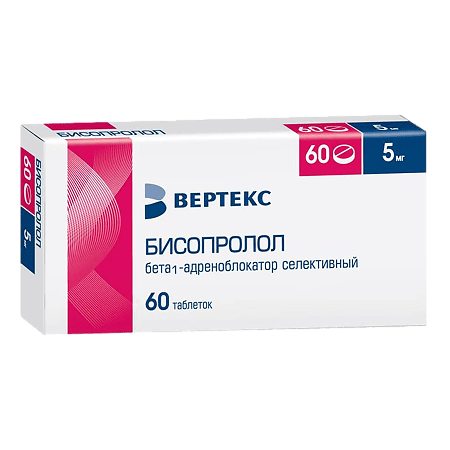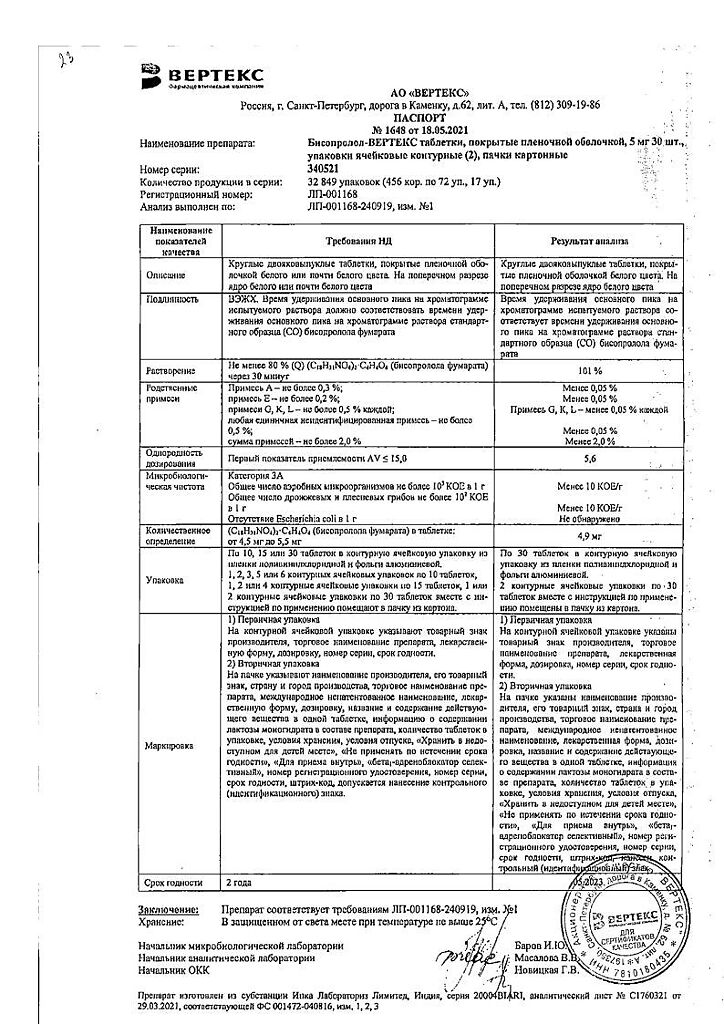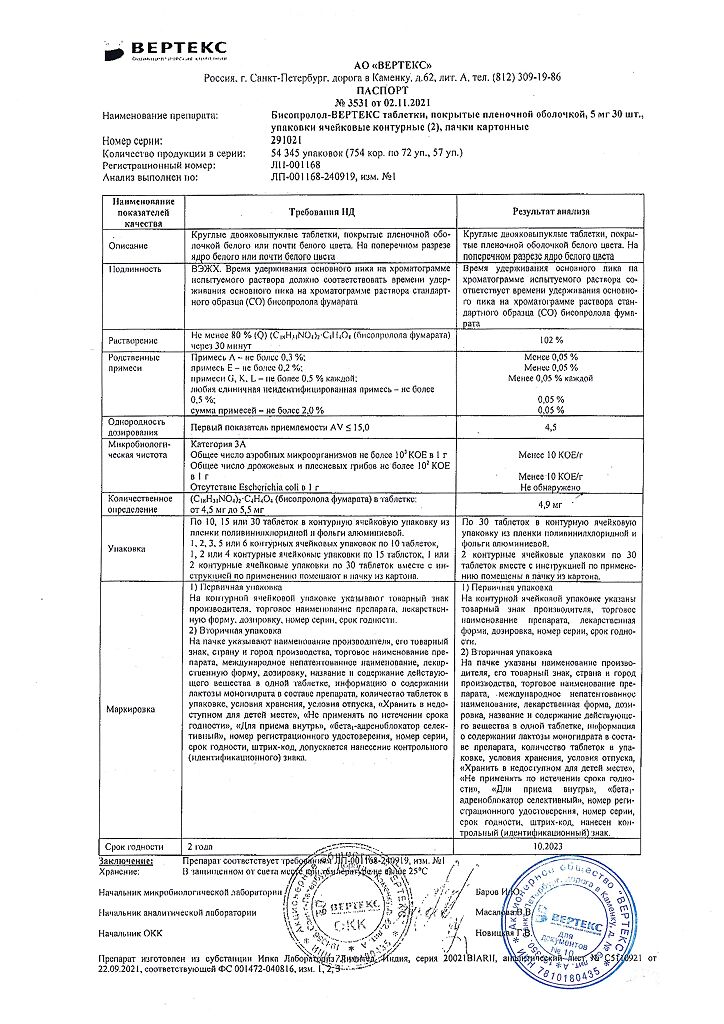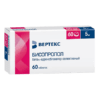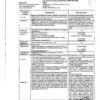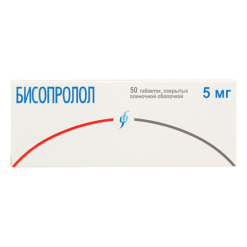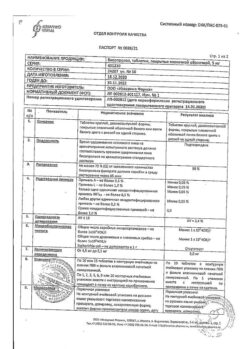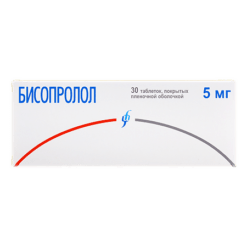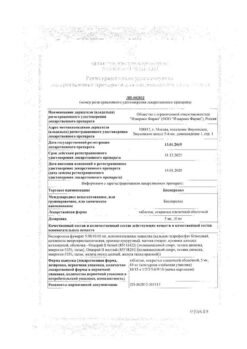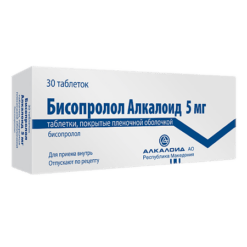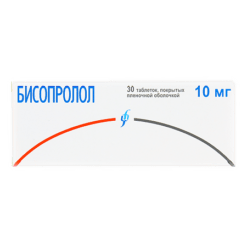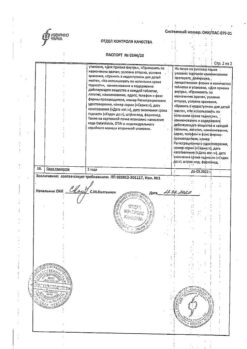No products in the cart.
Bisoprolol-Vertex, 5 mg 60 pcs.
€1.00
Out of stock
(E-mail when Stock is available)
Description
Pharmacotherapeutic group
Beta1-adrenoblocker selective
ATX code
C07AB
Pharmacodynamics:
Bisoprolol is a selective β1-adrenoblocker with no sympathomimetic activity of its own and has no membrane-stabilizing effects. As with other β1-adrenoblockers, the mechanism of action in arterial hypertension is unclear. At the same time, it is known that bisoprolol reduces plasma renin activity and decreases myocardial oxygen demand and decreases heart rate (HR). It has antihypertensive antiarrhythmic and antianginal effects.
Blocking in low doses β1-adrenoreceptors of heart reduces stimulated by catecholamines formation of cyclic adenosine monophosphate (cAMP) from adenosine triphosphate (ATP) reduces intracellular flow of calcium ions depresses all heart functions reduces atrioventricular (AV) conduction and excitability. If the therapeutic dose is exceeded, it has a β2-adrenoblocking effect. Total peripheral vascular resistance increases at the beginning of the drug administration during the first 24 hours (as a result of reciprocal increase of α-adrenoreceptor activity and elimination of β2-adrenoreceptor stimulation). It returns to initial value after 1-3 days and decreases with prolonged use.
The antihypertensive effect is related to the decrease of the minute blood volume by sympathetic stimulation of peripheral vessels decrease of sympathoadrenal system (SAS) activity (of great importance for patients with initial renin hypersecretion) restoration of sensitivity in response to blood pressure (BP) decrease and influence on the central nervous system. In arterial hypertension, the effect develops in 2-5 days, stable effect is noted after 1-2 months.
The antianginal effect is caused by decrease of myocardial oxygen demand as a result of decrease of contractility and other myocardial functions, prolongation of diastole and improvement of myocardial perfusion. By increasing left ventricular end-diastolic pressure and increasing ventricular muscle fiber stretch, oxygen demand may increase especially in patients with chronic heart failure (CHF).
In contrast to non-selective β-adrenoblockers, when used in medium therapeutic doses it has less pronounced effect on organs containing β2-adrenoreceptors (pancreas skeletal muscles smooth muscles of peripheral arteries of bronchi and uterus) and on carbohydrate metabolism; does not cause retention of sodium ions in the body; the severity of atherogenic action does not differ from that of propranolol.
Pharmacokinetics:
Bisoprolol is almost completely (over 90%) absorbed in the gastrointestinal tract food intake does not affect absorption. The effect of “primary passage” through the liver is insignificant (at 10-15%) resulting in high bioavailability (90%). Food intake has no effect on the bioavailability of bisoprolol.
Bisoprolol is metabolized by the oxidative pathway without subsequent conjugation. All metabolites are strongly polar and are excreted by the kidneys. The major metabolites detected in plasma and urine have no pharmacological activity. Experiments with human liver microsomes in vitro show that bisoprolol is metabolized primarily by CYP3A4 isoenzyme (approximately 95%) and CYP2D6 isoenzyme plays only a minor role.
The binding to plasma proteins is about 30%. Volume of distribution is 35 l/kg. Total clearance is approximately 15 l/h. Maximum concentration in blood plasma is determined after 2-3 hours. Blood-brain barrier and placental barrier permeability is low.
The plasma elimination half-life (10-12 hours) provides efficacy for 24 hours after a single daily dose.
Bisoprolol is eliminated from the body in two ways 50% of the dose is metabolized in the liver to form inactive metabolites. About 98% is excreted by the kidneys, of which 50% is excreted unchanged; less than 2% is excreted in the intestine (with the bile).
As excretion takes place in the kidneys and liver equally in patients with impaired liver function or with renal failure the dose adjustment is not required. The pharmacokinetics of bisoprolol are linear and independent of age.
Bisoprolol has higher plasma concentrations and longer half-life in patients with CHF compared to healthy volunteers.
There is no information about the pharmacokinetics of bisoprolol in patients with CHF and concomitant hepatic or renal impairment.
Indications
Indications
Arterial hypertension,
prevention of angina attacks,
chronic heart failure.
Pharmacological effect
Pharmacological effect
Pharmacotherapeutic group
Beta1-adrenergic blocker selective
ATX code
C07AB
Pharmacodynamics:
Bisoprolol is a selective β1-blocker without its own sympathomimetic activity and does not have a membrane-stabilizing effect. As with other β1-blockers, the mechanism of action in arterial hypertension is unclear. At the same time, it is known that bisoprolol reduces the activity of renin in the blood plasma, reduces the myocardial oxygen demand and reduces the heart rate (HR). It has antihypertensive, antiarrhythmic and antianginal effects.
By blocking β1-adrenergic receptors of the heart in low doses, it reduces the catecholamine-stimulated formation of cyclic adenosine monophosphate (cAMP) from adenosine triphosphate (ATP), reduces the intracellular current of calcium ions, inhibits all cardiac functions, reduces atrioventricular (AV) conductivity and excitability. When the therapeutic dose is exceeded, it has a β2-adrenergic blocking effect. The total peripheral vascular resistance at the beginning of the use of the drug in the first 24 hours increases (as a result of a reciprocal increase in the activity of α-adrenergic receptors and the elimination of stimulation of β2-adrenergic receptors); after 1-3 days it returns to its original value, and with long-term use it decreases.
The antihypertensive effect is associated with a decrease in minute blood volume, sympathetic stimulation of peripheral vessels, a decrease in the activity of the sympathoadrenal system (SAS) (of great importance for patients with initial hypersecretion of renin), restoration of sensitivity in response to a decrease in blood pressure (BP) and an effect on the central nervous system. In arterial hypertension, the effect develops after 2-5 days; a stable effect is observed after 1-2 months.
The antianginal effect is due to a decrease in myocardial oxygen demand as a result of decreased contractility and other myocardial functions, prolongation of diastole, and improved myocardial perfusion. Due to increased end-diastolic pressure in the left ventricle and increased stretch of ventricular muscle fibers, oxygen demand may increase, especially in patients with chronic heart failure (CHF).
When used in average therapeutic doses, in contrast to non-selective β-blockers, it has a less pronounced effect on organs containing β2-adrenergic receptors (pancreas, skeletal muscles, smooth muscles of the peripheral arteries of the bronchi and uterus) and on carbohydrate metabolism; does not cause sodium ion retention in the body; the severity of the atherogenic effect does not differ from the effect of propranolol.
Pharmacokinetics:
Bisoprolol is almost completely (more than 90%) absorbed from the gastrointestinal tract; food intake does not affect absorption. The effect of “first pass” through the liver is insignificant (at the level of 10-15%), which leads to high bioavailability (90%). Food intake does not affect the bioavailability of bisoprolol.
Bisoprolol is metabolized via the oxidative pathway without subsequent conjugation. All metabolites have strong polarity and are excreted by the kidneys. The main metabolites found in blood plasma and urine do not exhibit pharmacological activity. Data obtained from experiments with human liver microsomes in vitro show that bisoprolol is metabolized primarily by the CYP3A4 isoenzyme (about 95%) and the CYP2D6 isoenzyme plays only a minor role.
Communication with blood plasma proteins is about 30%. Volume of distribution – 35 l/kg. Total ground clearance is approximately 15 l/h. The maximum concentration in blood plasma is determined after 2-3 hours. Permeability through the blood-brain barrier and placental barrier is low.
The plasma half-life (10-12 hours) ensures effectiveness for 24 hours after a single daily dose.
Bisoprolol is excreted from the body in two ways; 50% of the dose is metabolized in the liver with the formation of inactive metabolites. About 98% is excreted by the kidneys, of which 50% is excreted unchanged; less than 2% – through the intestines (with bile).
Since excretion occurs equally in the kidneys and liver, no dosage adjustment is required in patients with impaired liver function or renal failure. The pharmacokinetics of bisoprolol is linear and does not depend on age.
In patients with CHF, plasma concentrations of bisoprolol are higher and the half-life is longer compared to healthy volunteers.
There is no information on the pharmacokinetics of bisoprolol in patients with CHF and concurrent impairment of liver or kidney function.
Special instructions
Special instructions
Monitoring the condition of patients taking the drug Bisoprolol should include measuring heart rate and blood pressure, conducting an ECG, determining blood glucose concentrations in patients with diabetes mellitus (once every 4-5 months). In elderly patients, it is recommended to monitor renal function (once every 4-5 months).
The patient should be trained in the method of calculating heart rate and instructed about the need for medical consultation if the heart rate is less than 50 beats/min.
Before starting treatment, it is recommended to conduct a study of external respiratory function in patients with a burdened bronchopulmonary history.
Patients using contact lenses should take into account that during treatment with the drug, the production of tear fluid may decrease.
When using the drug Bisoprolol in patients with pheochromocytoma, there is a risk of developing paradoxical arterial hypertension (if effective blockade of α-adrenergic receptors is not previously achieved).
In case of thyrotoxicosis, bisoprolol can mask certain clinical signs of thyrotoxicosis (for example, tachycardia). Abrupt withdrawal of the drug in patients with thyrotoxicosis is contraindicated because it can increase symptoms.
In diabetes mellitus, it can mask tachycardia caused by hypoglycemia. Unlike non-selective beta-blockers, it practically does not enhance insulin-induced hypoglycemia and does not delay the restoration of blood glucose concentrations to normal values.
When using clonidine simultaneously, its use can be discontinued only a few days after discontinuation of the drug Bisoprolol.
It is possible that the severity of the hypersensitivity reaction may increase and there will be no effect from the usual doses of epinephrine (adrenaline) against the background of a burdened allergological history.
If planned surgical treatment is necessary, the drug should be discontinued 48 hours before general anesthesia. If the patient took the drug before surgery, he should choose a drug for general anesthesia with minimal negative inotropic effect.
Reciprocal activation of the vagus nerve can be eliminated by intravenous atropine (1-2 mg).
Medicines that deplete the catecholamine depot (including reserpine) can enhance the effect of beta-blockers, so patients taking such combinations of drugs should be under constant medical supervision to detect a pronounced decrease in blood pressure or bradycardia.
Patients with bronchospastic diseases may be prescribed cardioselective β-blockers with caution in case of intolerance and/or ineffectiveness of other antihypertensive drugs. While taking β-blockers in patients with concomitant bronchial asthma, airway resistance may increase. If the dose of Bisoprolol is exceeded in such patients, there is a risk of developing bronchospasm.
If increasing bradycardia (heart rate less than 60 beats/min) or a pronounced decrease in blood pressure (systolic blood pressure less than 100 mmHg) of AV blockade is detected in patients, it is necessary to reduce the dose or discontinue treatment.
It is recommended to discontinue therapy with Bisoprolol if depression develops.
Treatment should not be abruptly interrupted due to the risk of developing severe arrhythmias and myocardial infarction. The drug is discontinued by gradually reducing the dose over 2 weeks or more (reduce the dose by 25% in 3-4 days).
The drug should be discontinued before testing the concentration of catecholamines normetanephrine vanillyl mandelic acid in the blood and urine and titers of antinuclear antibodies.
In smokers, the effectiveness of β-blockers is lower.
Impact on the ability to drive vehicles. Wed and fur.:
The use of the drug Bisoprolol does not affect the ability to drive vehicles according to the results of a study in patients with coronary artery disease. However, due to individual reactions, the ability to drive vehicles or operate technically complex mechanisms may be impaired. Particular attention should be paid to this at the beginning of treatment after changing the dose, as well as when consuming alcohol at the same time.
Active ingredient
Active ingredient
Bisoprolol
Composition
Composition
1 tablet contains:
Active substance:
bisoprolol fumarate 5 mg.
Excipients:
lactose monohydrate,
microcrystalline cellulose,
colloidal silicon dioxide,
crospovidone,
magnesium stearate.
Pregnancy
Pregnancy
Bisoprolol has pharmacological effects that may have a harmful effect on pregnancy and/or the fetus or newborn. Typically, β-blockers reduce placental perfusion, which leads to slower fetal growth, intrauterine fetal death, miscarriage or premature birth. Pathological reactions may occur in the fetus and newborn child (for example, hypoglycemia, bradycardia, arterial hypotension).
Bisoprolol should not be used during pregnancy; use is possible if the benefit to the mother outweighs the risk of side effects in the fetus and/or child. In the case when treatment with Bisoprolol is considered necessary, monitoring of uteroplacental blood flow and intrauterine development of the fetus should be carried out. If adverse effects on the pregnancy or fetus occur, alternative therapy should be considered. Symptoms of hypoglycemia and bradycardia usually occur within the first 3 days. The newborn should be carefully examined after birth.
There are no data on the excretion of bisoprolol into breast milk. Therefore, if it is necessary to use the drug during lactation, breastfeeding should be stopped.
Contraindications
Contraindications
Acute heart failure,
chronic heart failure in the stage of decompensation,
cardiogenic shock,
collapse,
AV block II and III degrees (without pacemaker),
SSSU;
sinoatrial blockade,
severe bradycardia (HR
Prinzmetal’s angina,
pronounced decrease in blood pressure (systolic blood pressure
history of severe forms of bronchial asthma and COPD,
late stages of peripheral circulatory disorders,
Raynaud’s disease,
pheochromocytoma (without simultaneous use of alpha-blockers),
metabolic acidosis,
simultaneous use of MAO inhibitors (except for MAO type B inhibitors),
children and adolescents up to 18 years of age,
hypersensitivity to bisoprolol and other beta-blockers.
Side Effects
Side Effects
The frequency of the adverse reactions listed below was determined according to the following (World Health Organization classification): very often – at least 10%; often – not less than 1% but less than 10%; infrequently – not less than 01% but less than 1%; rarely – not less than 001% but less than 01%; very rarely – less than 001% including individual messages.
From the heart and blood vessels: very often – decrease in heart rate (bradycardia especially in patients with CHF); feeling of heartbeat; often – a pronounced decrease in blood pressure (especially in patients with CHF) manifestation of vasospasm (increased peripheral circulatory disorders, feeling of coldness in the extremities (paresthesia); infrequently – disturbance of AV conduction (up to the development of complete transverse block and cardiac arrest) arrhythmias orthostatic hypotension aggravation of CHF with the development of peripheral edema (swelling of the ankles of the feet; shortness of breath) chest pain.
From the nervous system: often – dizziness, headache, asthenia, increased fatigue, sleep disturbances, depression, anxiety; rarely – confusion or short-term memory loss, “nightmarish” dreams, hallucinations, myasthenia gravis, tremor, muscle cramps. Typically, these phenomena are mild and usually disappear within 1-2 weeks after the start of treatment.
From the senses: rarely – visual impairment, decreased tear production (should be taken into account when wearing contact lenses), tinnitus, decreased hearing, pain in the ear; very rarely – dryness and soreness of the eyes, conjunctivitis, taste disturbances.
From the respiratory system: infrequently – bronchospasm in patients with bronchial asthma or obstructive airway diseases; rarely – allergic rhinitis; nasal congestion.
From the digestive system: often – nausea, vomiting, diarrhea, constipation, dry oral mucosa, abdominal pain; rarely – hepatitis, increased activity of liver enzymes (alanine aminotransferase, aspartate aminotransferase), increased bilirubin concentration, change in taste.
From the musculoskeletal system: infrequently – arthralgia, back pain.
From the genitourinary system: very rarely – impaired potency, weakened libido.
Laboratory indicators: rarely – increased concentration of triglycerides in the blood; in some cases – thrombocytopenia, agranulocytosis, leukopenia.
Allergic reactions: rarely – itching, rash, urticaria.
From the skin: rarely – increased sweating, skin hyperemia, exanthema, psoriasis-like skin reactions; very rarely – alopecia β-blockers can aggravate the course of psoriasis.
Other: withdrawal syndrome (increased frequency of angina attacks, increased blood pressure).
Interaction
Interaction
Combinations not recommended
Class I antiarrhythmic drugs (for example, quinidine disopyramide, lidocaine phenytoin, flecainide propafenone), when used simultaneously with bisoprolol, can reduce AV conduction and cardiac contractility.
Blockers of “slow” calcium channels (SCBC) such as verapamil and, to a lesser extent, diltiazem, when used simultaneously with bisoprolol, can lead to a decrease in myocardial contractility and impaired AV conduction. In particular, intravenous administration of verapamil to patients taking β-blockers can lead to severe arterial hypotension and AV block.
Centrally acting antihypertensives (such as clonidine methyldopa moxonidine rilmenidine) can lead to a decrease in heart rate and cardiac output, as well as vasodilation due to a decrease in central sympathetic tone. Abrupt withdrawal, especially before discontinuation of beta-blockers, may increase the risk of developing rebound hypertension.
Combinations requiring caution
Class III antiarrhythmic drugs (eg amiodarone) may worsen AV conduction disturbances.
The effect of β-blockers for topical use (for example, eye drops for the treatment of glaucoma) may enhance the systemic effects of bisoprolol (lowering blood pressure and lowering heart rate).
Parasympathomimetics, when used simultaneously with bisoprolol, may increase AV conduction disturbances and increase the risk of developing bradycardia.
The simultaneous use of Bisoprolol with β-adrenergic agonists (for example, isoprenaline dobutamine) may lead to a decrease in the effect of both drugs. The combination of bisoprolol with adrenomimetics affecting β- and α-adrenergic receptors (for example, norepinephrine, epinephrine) can enhance the vasoconstrictor effects of these drugs that occur with the participation of α-adrenergic receptors, leading to an increase in blood pressure. Such interactions are more likely when using non-selective beta-blockers.
Mefloquine, when used simultaneously with bisoprolol, may increase the risk of bradycardia.
Allergens used for immunotherapy or allergen extracts for skin testing increase the risk of severe systemic allergic reactions or anaphylaxis in patients receiving bisoprolol.
Iodine-containing x-ray contrast diagnostic agents for intravenous administration increase the risk of developing anaphylactic reactions.
Phenytoin, when administered intravenously as an inhalational anesthetic agent (hydrocarbon derivatives), increases the severity of the cardiodepressive effect and the likelihood of a decrease in blood pressure.
The effectiveness of insulin and hypoglycemic agents for oral administration may change during treatment with bisoprolol (masks the symptoms of developing hypoglycemia: tachycardia, increased blood pressure).
The clearance of lidocaine and xanthines (except theophylline) may be reduced due to a possible increase in their concentration in the blood plasma, especially in patients with an initially increased clearance of theophylline under the influence of smoking.
The antihypertensive effect is weakened by nonsteroidal anti-inflammatory drugs (NSAIDs) (sodium ion retention and blockade of prostaglandin synthesis by the kidneys), glucocorticosteroids and estrogens (sodium ion retention).
Cardiac glycosides methyldopa reserpine and guanfacine, slow calcium channel blockers (verapamil diltiazem), amiodarone and other antiarrhythmic drugs increase the risk of developing or worsening bradycardia, AV block, cardiac arrest and heart failure.
Nifedipine can lead to a significant decrease in blood pressure.
Diuretics clonidine, sympatholytics hydralazine and other antihypertensive drugs can lead to an excessive decrease in blood pressure.
The effect of non-depolarizing muscle relaxants and the anticoagulant effect of coumarins may be prolonged during treatment with bisoprolol.
Tricyclic and tetracyclic antidepressants, antipsychotics (neuroleptics), ethanol, sedatives and hypnotics increase depression of the central nervous system.
Concomitant use with MAO inhibitors (except for MAO B inhibitors) is not recommended due to a significant increase in the antihypertensive effect. Concomitant use may also lead to the development of a hypertensive crisis. The treatment break between taking MAO inhibitors and bisoprolol should be at least 14 days.
Non-hydrogenated ergot alkaloids increase the risk of developing peripheral circulatory disorders.
Ergotamine increases the risk of developing peripheral circulatory disorders.
Sulfasalazine increases the concentration of bisoprolol in the blood plasma.
Rifampin shortens the half-life of bisoprolol.
Overdose
Overdose
Symptoms: arrhythmia, ventricular extrasystole, severe bradycardia, AV block, marked decrease in blood pressure, acute heart failure, hypoglycemia, acrocyanosis, difficulty breathing, bronchospasm, dizziness, fainting, convulsions.
Treatment: if an overdose occurs, first of all, you must stop taking the drug, perform gastric lavage, prescribe adsorbents, and carry out symptomatic therapy.
For severe bradycardia, intravenous administration of atropine. If the effect is insufficient, a drug with a positive chronotropic effect can be administered with caution. Sometimes temporary placement of an artificial pacemaker may be necessary.
With a pronounced decrease in blood pressure, intravenous administration of plasma-substituting solutions and vasopressors.
For hypoglycemia, intravenous dextrose (glucose) may be indicated.
For AV block: patients should be closely monitored and treated with β-adrenergic agonists such as epinephrine. If necessary, install an artificial pacemaker.
In case of exacerbation of CHF, intravenous administration of diuretics, drugs with positive inotropic effects, as well as vasodilators.
For bronchospasm, prescribe bronchodilators, including β2-adrenergic agonists and/or aminophylline.
Storage conditions
Storage conditions
In a place protected from light at a temperature not exceeding 25 ° C.
Keep out of the reach of children.
Shelf life
Shelf life
3 years.
Do not use after expiration date.
Manufacturer
Manufacturer
Vertex, Russia
Additional information
| Shelf life | 3 years. Do not use after the expiration date. |
|---|---|
| Conditions of storage | In the dark place at a temperature not exceeding 25 °С. Store out of the reach of children. |
| Manufacturer | Vertex, Russia |
| Medication form | pills |
| Brand | Vertex |
Other forms…
Related products
Buy Bisoprolol-Vertex, 5 mg 60 pcs. with delivery to USA, UK, Europe and over 120 other countries.

